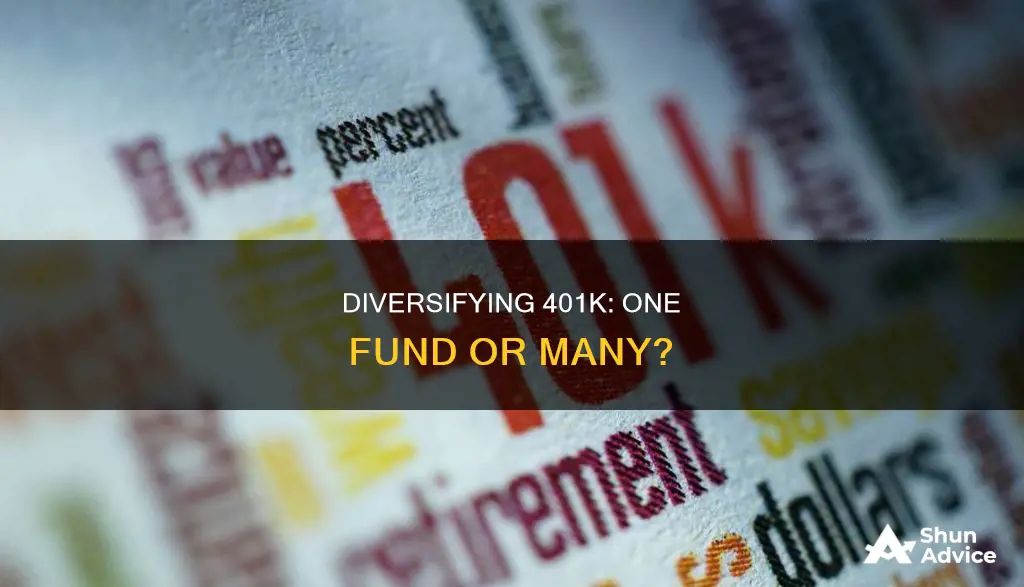
Deciding how to invest your 401(k) can be a tricky process. While opting into a 401(k) plan is relatively simple, only around a third of Americans understand how the account works, according to a ValuePenguin poll.
A 401(k) is a retirement investment account offered by an employer. It is tax-advantaged, meaning that the money contributed to it each year, usually a percentage of each paycheck, lowers your taxable income.
There are two types of 401(k)s: a traditional 401(k) and a Roth 401(k). With a traditional 401(k), you don't pay taxes on the money you put in now, but you do have to pay taxes on the money when you withdraw it later. With a Roth 401(k), you contribute money that has already been taxed, and then when you withdraw it, you don't pay taxes.
When it comes to investing your 401(k), you have a few options. You can either choose to diversify your investments or put all your money into one fund. Diversifying your investments reduces risk while still allowing your money to grow. This means that if one of your investments performs poorly, you won't lose everything. However, putting all your money into one fund may offer the potential for higher returns.
If you decide to diversify, you can invest in a variety of funds, including mutual funds, exchange-traded funds (ETFs), and target-date funds. These funds typically invest in a mix of stocks and bonds, with different levels of risk and potential return.
On the other hand, if you choose to put all your money into one fund, you'll need to carefully select the right fund for your needs. This may involve considering factors such as the fund's historical performance, fees, and the types of companies and sectors it invests in.
Ultimately, the decision to diversify or focus on one fund depends on your financial goals, risk tolerance, and investment strategy. It's important to carefully consider your options and seek professional advice before making any decisions about your 401(k).
| Characteristics | Values |
|---|---|
| Risk | The level of risk you are willing to take should inform your investment strategy. |
| Time horizon | The time horizon of your investment will determine the level of risk you can take. |
| Diversification | Diversifying your investments across different asset classes and sectors reduces risk and allows your money to grow. |
| Fees | Avoid funds with high fees. |
| Tax advantages | 401(k)s offer tax advantages, such as tax-deductible contributions and tax-free withdrawals in retirement. |
| Employer match | Contribute enough to your 401(k) to maximise your employer's match. |
| Rebalancing | Review and rebalance your portfolio periodically to maintain your desired asset allocation. |

Risk tolerance
Understanding Risk Tolerance
Time Horizon
Your time horizon, or how long you plan to invest for, is a crucial factor in determining your risk tolerance. Generally, if you have a longer time horizon, you can afford to take on more risk, as you have more time to recover from potential losses. Younger investors, for example, tend to have a higher risk tolerance because they have a longer investment horizon.
Risk Capacity and Risk Tolerance
It's important to distinguish between risk capacity and risk tolerance. Risk capacity refers to your financial ability to take on risk, while risk tolerance refers to your psychological willingness to do so. For example, someone with a high net worth and stable income may have a higher risk capacity, while someone who is more comfortable with stable, guaranteed returns may have a lower risk tolerance.
Market Volatility
Consider how you would react to market volatility. If the market experiences a downturn, and your portfolio value starts to decrease, how would you respond? If you're the type of person who would panic and sell your investments, you may have a lower risk tolerance. On the other hand, if you're comfortable with market fluctuations and willing to ride them out, you may have a higher risk tolerance.
Risk and Return
It's important to understand the relationship between risk and return. Generally, investments with higher risk offer the potential for higher returns, while lower-risk investments tend to provide more stable, but lower, returns. If you're comfortable with the potential for larger swings in your portfolio value, you may have a higher risk tolerance.
Your risk tolerance will influence your asset allocation, or how you distribute your investments across different asset classes. A higher risk tolerance may lead to a larger allocation of stocks or equity funds, while a lower risk tolerance may result in a greater allocation of bonds or fixed-income investments.
There are various risk tolerance assessments and formulas available to help you quantify your risk tolerance. For example, financial advisors often recommend the formula: 110 (or 100) minus your age equals the percentage of your portfolio that should be invested in stocks, with the remainder in bonds. Additionally, there are risk tolerance quizzes and assessments, such as the Investment Risk Tolerance Assessment created by Dr. Ruth Lytton and Dr. John Grable.
In conclusion, understanding your risk tolerance is crucial when deciding whether to diversify your 401(k) or invest in a single fund. It helps guide your investment strategy, asset allocation, and overall financial plan. By considering factors such as time horizon, risk capacity, market volatility, risk-return relationship, and risk tolerance assessments, you can make more informed decisions about your investments.
Target-Date Funds: A Comprehensive Guide to Investing Wisely
You may want to see also

Asset allocation
Risk and Time Horizon:
Your risk tolerance and investment time horizon are essential factors in determining your asset allocation. Younger investors with a longer time horizon can generally afford to take on more risk, while older investors approaching retirement may want to adopt a more conservative approach. Consider your ability and willingness to take risks and adjust your allocation accordingly.
Diversification:
Diversification is a fundamental principle of investing. By spreading your investments across different asset classes, sectors, and geographic regions, you reduce the risk of losing everything if one investment performs poorly. Diversification can be achieved by investing in mutual funds or exchange-traded funds (ETFs) that hold a variety of stocks and bonds. Aim for a mix of large-cap, mid-cap, small-cap, international, and domestic funds to ensure your portfolio is well-diversified.
Stock and Bond Allocation:
The allocation between stocks and bonds is a critical decision. Stocks typically offer higher potential returns but come with greater volatility, while bonds provide more stable and predictable returns. As a rule of thumb, subtract your age from 110 or 100 to determine the percentage of your portfolio that should be invested in stocks, with the remainder in bonds. However, this may vary depending on your risk tolerance and investment goals.
Fund Selection:
When selecting funds for your 401(k), consider the fees associated with each fund, as these can eat into your returns over time. Opt for low-cost index funds or ETFs that track a broad market index, such as the S&P 500. These funds provide diversification at a lower cost compared to actively managed funds. Additionally, consider the fund's performance over the long term rather than just focusing on recent returns.
Regular Rebalancing:
Once you've established your asset allocation, it's important to review and rebalance your portfolio periodically. Over time, certain investments may outperform others, causing your allocation to deviate from your original plan. By rebalancing, you ensure your portfolio remains aligned with your desired level of risk and investment strategy.
Renaissance Fund: Investing in the Future of Innovation
You may want to see also

Mutual funds
There are several types of mutual funds, including:
- Conservative funds: These funds avoid risk by investing primarily in high-quality bonds and other safe investments. They offer slow and predictable growth and are a good option for those averse to risk.
- Value funds: Value funds invest in solid, stable companies that are undervalued and typically pay dividends. They are considered a middle-ground option in terms of risk.
- Balanced funds: Balanced funds add a few more risky equities to a mix of mostly value stocks and safe bonds, or vice versa. They offer a moderate level of risk.
- Aggressive growth funds: These funds focus on finding the next big thing in the market but come with a higher risk of loss.
- Target-date funds: These funds are based on your expected retirement date and are designed to maximize your investment around that time. As the target date approaches, the fund's investments become more conservative.
When choosing a mutual fund for your 401(k), it is important to consider your risk tolerance, age, and investment goals. You should also pay attention to fees, as these can eat into your returns over time. It is generally recommended to choose index funds, which have lower fees and are passively managed, meaning they follow a stock market index rather than actively picking companies.
Index Funds: A Beginner's Guide to Investing in Australia
You may want to see also

Expense ratios
When it comes to saving for retirement, it's common to encounter fees, and the expense ratio is one of the most common. These fees cover costs associated with managing your investments. The expense ratio is calculated by dividing a fund's operating expenses by the average value of its net assets. It's helpful to think of the expense ratio as the fee paid to the fund company for their management of the fund. It covers things like administrative fees, legal services, marketing and distribution costs. The expense ratio is the total of all of these fees charged by the fund.
An expense ratio is shown as a percentage and is charged on your average net investment in that fund. For example, if you have an expense ratio of 0.30%, you'll pay $3 annually for every $1,000 you invest in the fund. While these fees are charged on an annual basis, you may see them appear on your account more regularly, such as on a monthly basis, depending on the fund.
A mutual fund or exchange-traded fund (ETF) is a collection of individual assets like stocks or bonds that are managed by a fund company. Because they are already a mix, these funds help an investor diversify their investments.
You can reduce your 401(k) expense ratios by calculating the expense ratio you are currently paying, comparing plans using a website like BrightScope, and approaching your employer's plan administrator if your fees are much higher than average. You might also be paying for independent investment advice, which can add up to 1% of your expense ratio. You can likely stop paying for this advice and replace it with your own research or a one-off consultation with a certified financial planner. Finally, you can try to reduce the cost of your actual investments by choosing index funds, institutional funds, and some target-date funds, which tend to have lower fees.
Even small differences in expense ratios can make a big difference when it comes to the final size of your retirement portfolio. Research by the Pew Charitable Trusts confirms that fees have a serious impact, noting that "fees can affect savings directly by reducing the amount saved, and indirectly by lowering the amount available for compounding—a frequently overlooked but significant detriment to savings growth."
A Guide to Investing Money in Pag-Ibig Fund
You may want to see also

Target-date funds
The main advantage of TDFs is their simplicity and the built-in diversification they offer. These funds are typically well-diversified across asset classes, sectors, and even globally, providing instant exposure to a wide range of investments. The asset mix is based on the retirement timeline, so for investors with a longer time horizon, the fund will be weighted towards stocks, and as the target date nears, it will shift to include more bonds and less volatile assets. This automatic adjustment means an investor doesn't need to worry about rebalancing their portfolio over time.
Additionally, TDFs are managed by professional investment managers who make the asset allocation decisions, taking the stress and guesswork out of investing. These funds are also a cost-effective option, as they are typically low-maintenance and have relatively low expense ratios, especially when compared to hiring a financial advisor for personalized portfolio management.
However, one potential downside of TDFs is the lack of customization. The asset allocation is based on a general retirement timeline, and while it may suit the average investor, it might not be tailored enough for those with specific needs or preferences. For example, an investor may want to take on more risk or have a particular interest in certain sectors, and a TDF doesn't allow for that level of customization. Additionally, while TDFs are designed to become more conservative over time, some investors may want more control over this process, especially those with a higher risk tolerance.
Despite these potential drawbacks, TDFs can be a great option for investors who want a simple, low-maintenance approach to their 401(k) investment strategy, especially those who are just starting their investment journey or have a long time horizon before retirement. They offer instant diversification, professional management, and a straightforward way to save for retirement.
For those considering TDFs, it is important to remember that not all target-date funds are created equal, and it is worth researching the specific funds offered by your 401(k) plan provider to understand the underlying investments, fees, and performance. It is also crucial to keep in mind that while TDFs offer a simple solution, investors should still regularly review their 401(k) balance and the fund's performance to ensure it is on track and meeting their retirement goals.
A Guide to Investing in Vanguard Funds from South Africa
You may want to see also
Frequently asked questions
Diversification is a strategy that reduces risk by spreading your money across different types of investments, allowing your money to grow. This is a basic principle of investing and is often likened to the saying "don't put all your eggs in one basket".
Investing in a single fund means that if that fund fails, you lose everything. It is recommended to take a more balanced approach to building wealth, especially for retirement funds such as 401ks.
There are several ways to diversify your 401k. You can choose to invest in a range of mutual funds, such as growth and income, growth, aggressive growth, and international funds. Alternatively, you can opt for a target-date fund, which automatically adjusts your asset allocation over time based on your target retirement date.







